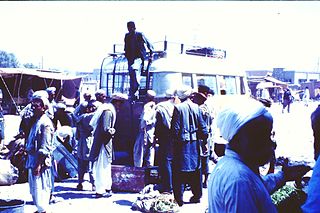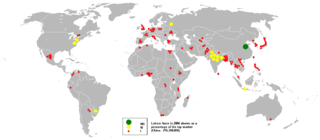Related Research Articles

Libya, officially the State of Libya, is a country in the Maghreb region in North Africa bordered by the Mediterranean Sea to the north, Egypt to the east, Sudan to the southeast, Chad to the south, Niger to the southwest, Algeria to the west, Tunisia to the northwest, and maritime borders with Malta and Greece. The sovereign state is made of three historical regions: Tripolitania, Fezzan and Cyrenaica. With an area of almost 700,000 square miles, Libya is the fourth largest country in Africa, the second largest in the Arab World and Arab League behind Algeria and the 16th largest country in the world. Libya has the 10th-largest proven oil reserves of any country in the world. The largest city and capital, Tripoli, is located in western Libya and contains over three million of Libya's seven million people.

Though the Ministry of Foreign Affairs (MOFA) is the government agency responsible for the conduct of foreign relations of Nepal, historically, it is the Office of Prime Minister (PMO) that has exercised the authority to formulate and conduct policies related to Nepal's foreign affairs. As a landlocked country wedged between two larger and far stronger powers, Nepal has tried to maintain good relations with both of its neighbors, People's Republic of China and Republic of India. However, its relationship with India, remains utmost priority due to open border and similarity in culture, tradition, geography, living practices. The relationship between the two countries was significantly hampered during the 2015 Nepal blockade. Where the Nepal Government accused India of the blockade, India strictly denied the allegation and said the blockade were imposed by Madheshi protesters. For the most part though, Nepal has traditionally maintained a non-aligned policy and enjoys friendly relations with its neighboring countries and almost all the major countries of the world.

The Lhotshampa or Lhotsampa people are a heterogeneous Bhutanese people of Nepalese descent. The Lhotshampa people, native to southern Bhutan, are thus colloquially referred to as Southerners. Starting in 2007, most of the Lhotshampas, or Bhutanese Refugees, were resettled to various countries, such as the United States, Canada, Australia, the United Kingdom, and other European countries. As of 2021 the number of Lhotshampa in Nepal is significantly lower than that in the United States and other countries where they have resettled. People of Nepalese origin started to settle in uninhabited areas of southern Bhutan in the 19th century.

Nepal, officially the Federal Democratic Republic of Nepal, is a landlocked country in South Asia. It is mainly situated in the Himalayas, but also includes parts of the Indo-Gangetic Plain, bordering Tibet of China to the north, and India in the south, east, and west, while it is narrowly separated from Bangladesh by the Siliguri Corridor, and from Bhutan by the Indian state of Sikkim. Nepal has a diverse geography, including fertile plains, subalpine forested hills, and eight of the world's ten tallest mountains, including Mount Everest, the highest point on Earth. Nepal is a multi-ethnic, multi-lingual, multi-religious and multi-cultural state, with Nepali as the official language. Kathmandu is the nation's capital and the largest city.
Prostitution in Nepal is illegal. The Human Trafficking and Transportation (Control) Act, 2064, Act Number 5 of the Year 2064 (2008), criminalises prostitution and living of the earnings of prostitution by including it in the definition of human trafficking. UNAIDS estimate there to be 67,300 prostitutes in the country.

Illegal immigration refers to the migration of people into a country in violation of the immigration laws of that country, or the continued residence without the legal right to live in that country. Illegal immigration tends to be financially upward, from poorer to richer countries. Illegal residence in another country creates the risk of detention, deportation, and/or other sanctions.

Bhutanese refugees are Lhotshampas ("southerners"), a group of Nepali language-speaking Bhutanese people. These refugees registered in refugee camps in eastern Nepal during the 1990s as Bhutanese citizens deported from Bhutan during the protest against oppressive measures of Bhutanese government by some of the Lhotshampas demanding Human Rights and democracy in Bhutan. As Nepal and Bhutan have yet to implement any agreement on repatriation, many Bhutanese refugees have since resettled to North America, Oceania and Europe under the auspices of the Office of the United Nations High Commissioner for Refugees. Many Lhotshampa also migrated to areas of West Bengal and Assam in India independently of the UNHCR.

Israel–Nepal relations, established on 1 June 1960, are the relations between Israel and Nepal making Nepal one of the first Asian countries to have diplomatic ties with Israel.

India–Nepal relations are the bilateral relations between India and Nepal. Both countries initiated their relationship with the 1950 Indo-Nepal Treaty of Peace and Friendship and accompanying secret letters that defined security relations between the two countries, and an agreement governing both bilateral trade and trade transiting Indian territory. The 1950 treaty and letters exchanged between the then Indian government and Rana rulers of Nepal, stated that "neither government shall tolerate any threat to the security of the other by a foreign aggressor" and obligated both sides "to inform each other of any serious friction or misunderstanding with any neighboring state likely to cause any breach in the friendly relations subsisting between the two governments." These accords cemented a "special relationship" between India and Nepal. The treaty also granted Nepalese the same economic and educational opportunities as Indian citizens in India, while accounting for preferential treatment to Indian citizens and businesses compared to other nationalities in Nepal. The Indo-Nepal border is open; Nepalese and Indian nationals may move freely across the border without passports or visas and may live and work in either country. However, Indians are not allowed to own land-properties or work in government institutions in Nepal, while Nepalese nationals in India are allowed to work in some Indian government institutions notably the Indian military. An estimated 32,000 Nepalese citizens are employed as active duty soldiers in the Indian army and further 1 million Nepali-migrant workers are believed to be spread throughout India while Indian embassy in Nepal has reported that 600,000 Indian citizens in Nepal have registered their paperwork with the Indian embassy in Kathmandu as of 2021. The number of Indian immigrants who haven't registered their paperwork with the Indian embassy in Kathmandu isn't known as of 2021, however, Government of Nepal has announced that all people living within the boundaries of Nepal will be counted in the upcoming census of 2021.
Egyptian diaspora consists of citizens of Egypt abroad sharing a common culture and Egyptian Arabic language.
According to Non resident Nepali act, 2007 Non Resident Nepali (NRN) means the following:
Nepalese Canadians or Nepali Canadians are Canadians with roots in Nepal.
Human trafficking in Nepal is a growing criminal industry affecting multiple other countries beyond Nepal, primarily across Asia and the Middle East. Nepal is mainly a source country for men, women and children subjected to the forced labor and sex trafficking. U.S. State Department's Office to Monitor and Combat Trafficking in Persons placed the country in "Tier 2" in 2017.
The international reactions to the Libyan Civil War were the responses to the series of protests and military confrontations occurring in Libya against the government of Libya and its de facto head of state Muammar Gaddafi.
Nepalis in Poland are migrants from Nepal to Poland, mainly expatriate workers and international students.
Refugees of the Libyan Civil War are the people, predominantly Libyans, who fled or were expelled from their homes during the First Libyan Civil War (2011), from within the borders of Libya to the neighbouring states of Tunisia, Egypt and Chad, as well as to European countries across the Mediterranean. The majority of Libyan refugees are Arab-Berbers, though many of the other ethnicities temporarily living in Libya originated from sub-Saharan Africa. These groups were also among the first refugee waves to exit the country. The total number of Libyan refugees were estimated at around one million as of June 2011 and most returned after the First Civil War ended. As of January 2013, there were 5,252 refugees originating from Libya alongside 59,425 internally displaced persons registered by the UNHCR.

By the end of February 2011, medical supplies, fuel and food were dangerously low in Libya. On 25 February, the International Committee of the Red Cross launched an emergency appeal for US$6,400,000 to meet the emergency needs of people affected by the violent unrest in Libya. On 2 March, the ICRC's director general reminded everyone taking part in the violence that health workers must be allowed to do their jobs safely.

The Second Libyan Civil War was a multi-sided civil war that lasted from 2014 to 2020 in the North African country of Libya fought between different armed groups, mainly the House of Representatives and the Government of National Accord.

On June 20, 2016, at around 0600 AFT, a suicide bombing attack claimed to be conducted by the Taliban or the Islamic State in Khorasan Province (IS-KP) hit a convoy of Canadian embassy security guards en route to the embassy in Kabul. The attack took place in the ninth police district in the Benayi area, Kabul, Afghanistan. Thirteen Nepalese and two Indian contractors were killed in the attack.

Nepal has a labour force of 16.8-million-workers, the 37th largest in the world as of 2017. Although agriculture makes up only about 28 per cent of Nepal's GDP, it employs more than two-thirds of the workforce. Millions of men work as unskilled labourers in foreign countries, leaving the household, agriculture, and raising of children to women alone. Most of the working-age women are employed in agricultural sector, contributions to which are usually ignored or undervalued in official statistics. Few women who are employed in the formal sectors face discrimination and significant wage gap. Almost half of all children are economically active, half of which are child labourers. Millions of people, men, women and children of both sexes, are employed as bonded labourers, in slavery-like conditions. Trade unions have played a significant role in earning better working conditions and workers' rights, both at the company level and the national government level. Worker-friendly labour laws, endorsed by the labour unions as well as business owners, provide a framework for better working conditions and secure future for the employees, but their implementation is severely lacking in practice. Among the highly educated, there is a significant brain-drain, posing a significant hurdle in fulfilling the demand for skilled workforce in the country.
References
- ↑ "Govt bailing out Nepalis from Libya". The Kathmandu Post. 22 February 2011. Archived from the original on 24 February 2011. Retrieved 2019-10-16.
- ↑ "Over 1,200 Nepali workers are back". The Himalayan Times. 6 March 2011. Archived from the original on 2011-08-17. Retrieved 2019-10-16.
- ↑ "Nepalese workers arrive home from Libya". Monsters & Critics. 27 February 2011. Archived from the original on 2011-02-27. Retrieved 2019-10-16.
- ↑ The Rising Nepal -Stranded Nepalese in Libya reaching Egypt border [ dead link ]